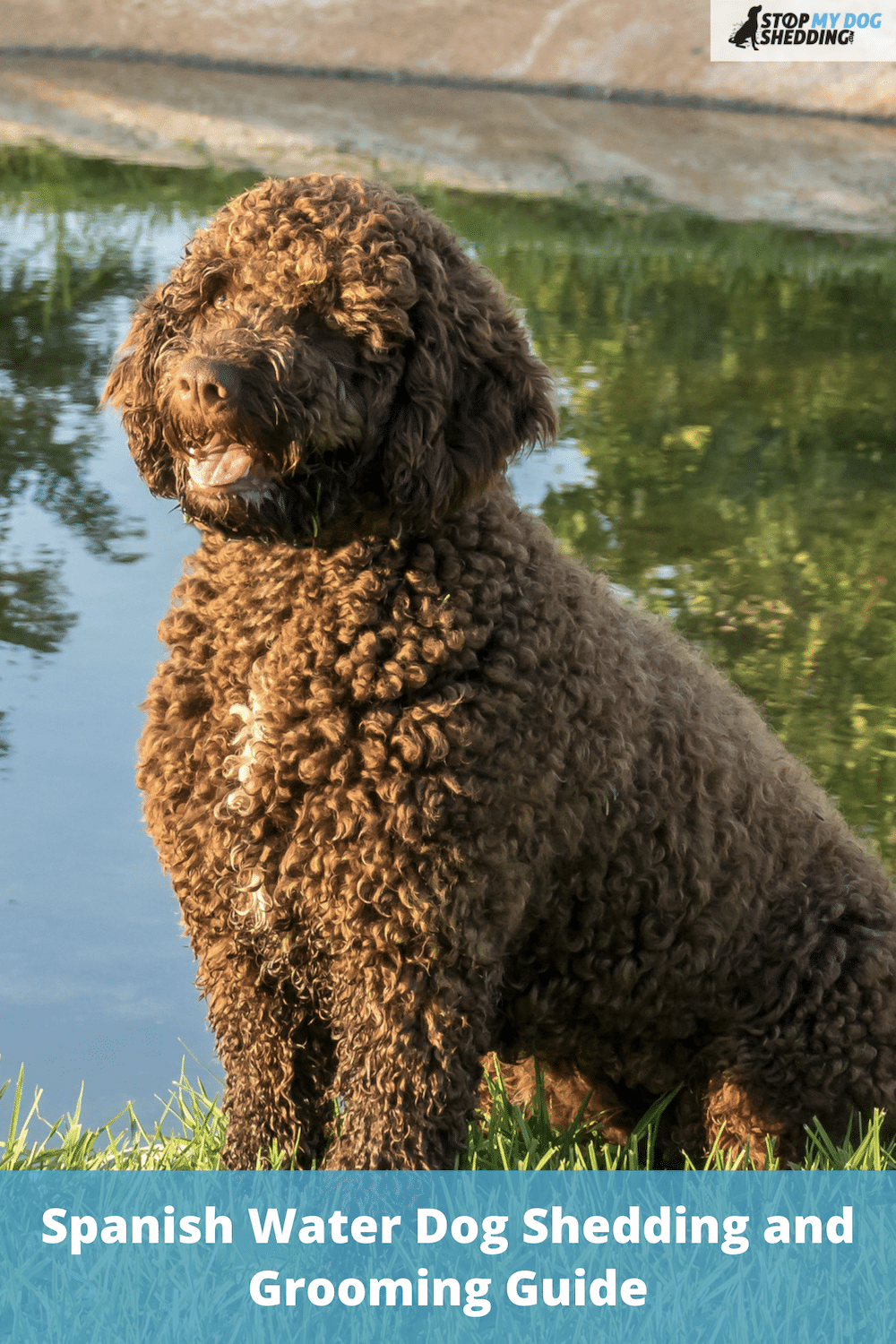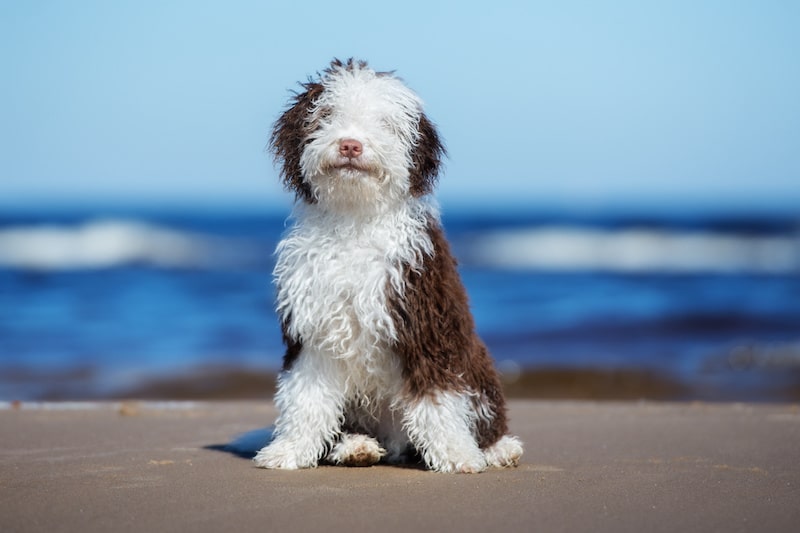The Spanish Water Dog or SWD is a mid-sized guard dog and sheepdog that hails from Spain. Its shaggy, corded coat makes this breed look very distinct. You might be interested in adopting one of these dogs, but not before knowing how much they shed.
So, are Spanish Water Dogs heavy shedders?
Spanish Water Dogs do not shed much because they’re single-coated. Their corded fur, which is dreadlocked, comes out only periodically and not during seasonal spikes. Grooming the SWD’s coat is more challenging by comparison, as you have to de-mat the fur, and you can’t brush it.
This guide to Spanish Water Dog shedding and grooming will fill you in on everything you’d like to know to decide if you want to adopt this sweet, shaggy canine. Make sure you keep reading!
Recommended: Go here to see our top-rated dog hair blow dryers
Spanish Water Dog Shedding
The Spanish Water Dog is a good pick if you want a bigger breed that doesn’t shed tons.
The dog that is sometimes called the Luffy has a rather unique coat that’s key to its minimal shedding.
In its youth, the SWD’s coat starts off with a somewhat scruffy look. What grows over time are a series of cords or dreadlocks.
The Puli might be the best-known dreadlocked dog, but the SWD has ’em too.
The tightly-wound cords keep loose fur trapped within each. The hair will come out eventually but in small increments.
It likely won’t be enough to notice, so you’ll only have to worry about marginal cleanup.
Adding further to the SWD’s low-shedding nature is that the breed has a single coat.
As you may know, if you read this blog, double-coated dogs have an insulating undercoat and a dirt and water-repelling outer coat. Twice per year, they blow their coat to downsize for the summer and bulk up for the winter.
The Spanish Water Dog will not shed seasonally like that because it’s not part of its DNA. The same amount of shed hair you see in the spring will be what you should expect in the autumn and the winter.
That said, if your SWD is shedding more than usual, that could be due to dietary issues, food allergies, nutritional deficiencies, bathing too frequently, or even insect infestations like fleas. So I recommend a vet visit if you have any concerns.
Recommended: Go here to see our top-rated dog hair blow dryers
Grooming Your Spanish Water Dog
While you will save time cleaning up after your SWD’s loose fur, that spare time should be funneled right back into grooming.
The Spanish Water Dog has very specific grooming requirements that are time-intensive.
Let me start with something that will feel foreign if you read this blog enough. I always recommend brushing your dog regularly to control their loose fur. Ideally, it’s best not to brush the SWD. Not with a brush, not with a comb, not at all.
If you attempt to brush the cords, you can pull on them. Not only are you yanking on the SWD’s dreadlocks, but the skin they’re connected to. Your dog will be in quite a lot of pain.
That said, you should keep your eyes peeled for mats, knots, and tangled cords, which can happen. The longer the cords grow out, the likelier they are to get felty or matted.
Check around the rear, legs, neck, and ears especially, as these areas are the most prone to mats. Rather than reach for the dog-grooming scissors if you spot tangles, you should use your fingers to pull the mats apart.
At the top of the mat, work your fingers between it and separate it all the way down to your SWD’s skin. Repeat for every mat.
Trimming your Spanish Water Dog is another facet of its grooming routine. You won’t have to do this too often, maybe once or twice a year.
When trimming, use a tool like a #5 or #5F skip tooth blade. Select one length for your SWD’s fur, as that will be its uniform length all over. The rule of thumb is to trim a quarter of an inch of your SWD’s coat.
If you feel too nervous doing all this cutting, you can always bring your Spanish Water Dog to your groomer!
Once you’re done trimming him, it might be bath time for your SWD. When you bathe this breed, you want to use a mild doggy shampoo.
It’s not enough to cover your dog in shampoo. You need to go through each cord and squeeze the shampoo in to ensure you’re cleaning the entirety of the cord.
I should note that squeezing and rubbing aren’t the same. A few firm squeezes will get the shampoo into all hairs of the cord. Rubbing will only knot or tangle the SWD’s fur.
It will take longer to rinse your dog after bathing since all the sudsy shampoo residue needs to come out of your Spanish Water Dog’s fur. If you still see soap bubbles when rinsing, then continue rinsing until all the bubbles are gone.
Leaving shampoo residue in your dog’s coat could cause irritation. They’ll begin itching their skin and could shed more!
You should not towel-dry your SWD. Instead, you’ll have to go one cord at a time and squeeze all the excess water out. Then let the dog’s coat air-dry.
Please do ensure the Spanish Water Dog’s coat is entirely dry. Unfortunately, due to the entrapped areas of fur, the SWD can develop mildew in its fur.
Recommended: Go here to see our top-rated dog hair blow dryers
Is a Spanish Water Dog Right for You?
Are you debating whether a Spanish Water Dog could be the breed you’re looking for? Here’s more information to help in your decision-making.
The Spanish Water Dog or perro de agua espanol is a mid-sized canine from Spain that was once a guard dog, gundog, and sheepdog.
Fun fact: there were three unique SWD species at one time that were of varying sizes. They lived in different parts of Spain, including Cantabria, Asturias, and Northern Spain.
The Cantabrian Water Dog is one branch of these original SWDs, and today’s Spanish Water Dog is another.
The SWD is described as upbeat, kind, and very active.
Reaching sizes of nearly 20 inches in adulthood (for the males, at least), Spanish Water Dogs are no small canines. In a very enclosed environment such as an apartment, the SWD might feel too trapped.
Plus, this dog needs a lot of exercise, so you’d have to commit to taking him to the dog park often. Indoors, the SWD likes playtime as well, which is why homeowners or those in bigger apartments might be better suited for this dog.
Are you thinking of integrating your Spanish Water Dog with other four-legged friends in the household? With socialization, the SWD is known to befriend most dogs. This breed is especially non-aggressive. I can’t stress enough, though, that socialization is still required!
As for the SWD’s relationship with smaller animals like cats or rabbits, it’s not a violent one, per se, but it’s not ideal either. This dog still has herding instincts, and so the SWD will attempt to herd smaller creatures in the house like sheep.
Those smaller creatures can include children too, by the way! So, early socialization might also help the Spanish Water Dog act less on its herding tendencies around the home.
As a watchdog, the SWD will bark to let you know that danger could be afoot. If your canine companion exhibits anxiety, that’s another instance in which barking might increase. It can also be an issue if your SWD is saying hello or feeling bored.
Bottom Line
The Spanish Water Dog or SWD is a Spanish-bred watchdog and herding dog that has cords throughout.
Those cords spare you a shedding nightmare but will require a lot of time, patience, and upkeep to maintain. It’s not a bad idea to have the number handy of a groomer who specializes in Spanish Water Dogs.
Either way, this big, loveable, family-friendly pup will be a protective companion should you decide to bring one home!













Please note: By submitting a comment using the above comment form, you confirm that you agree with the storage and handling of your data by this site as detailed in our Privacy Policy.